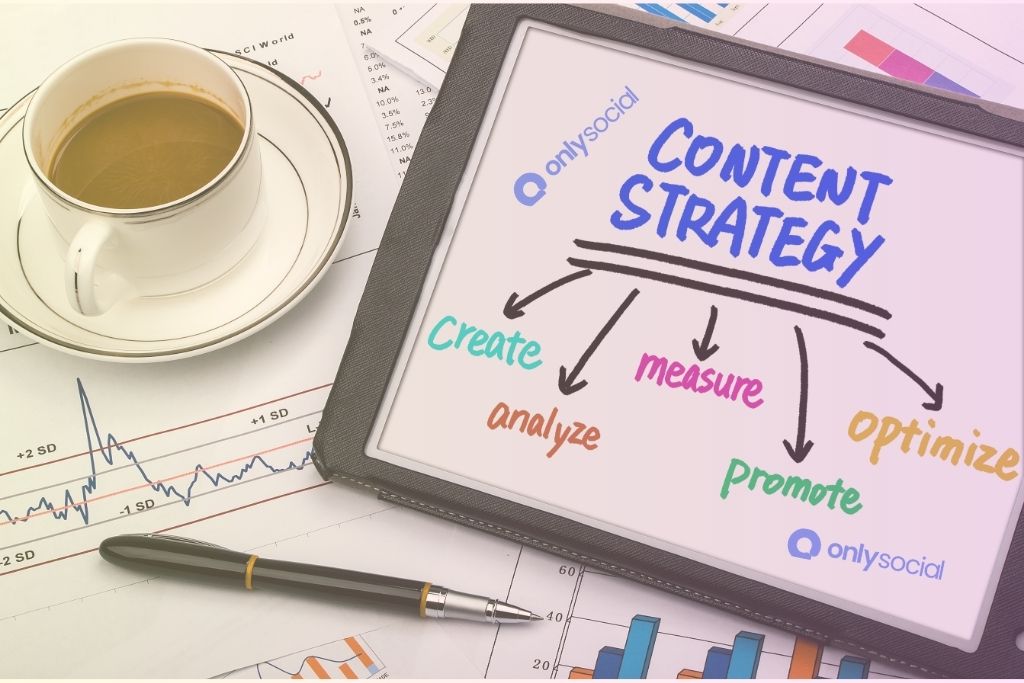As we navigate through 2024, the digital world continues to evolve at an unprecedented pace, and with it, the realm of content creation and marketing undergoes constant transformation. In this dynamic landscape, developing a robust and effective content strategy is not just beneficial—it’s essential for any brand or individual looking to make a significant impact online. This brings us to the crucial question: “How to Create a Content Strategy That Works in 2024?” In this comprehensive guide, we aim to answer this question, providing you with the latest insights and methodologies for crafting a content strategy that resonates with your audience and achieves your objectives.
Content strategy has always been the backbone of successful digital marketing, but in 2024, its importance is magnified by the ever-changing consumer behaviors and technological advancements. Whether you’re a small business owner, a marketing professional, or a content creator, understanding how to navigate these changes and align your content with your audience’s needs and preferences is paramount.
This article will take you through the essential steps of creating a content strategy in 2024, from understanding the basics of what content strategy entails to analyzing your audience, planning and creating engaging content, choosing the right distribution channels, and measuring the impact of your efforts. We’ll also delve into the latest trends and tools that are shaping content strategy today, ensuring you have a forward-thinking approach that keeps you ahead in the game.
So, let’s embark on this journey to build a content strategy that not only works in 2024 but sets you up for long-term success in the ever-evolving digital world.
Table of Contents
- 1 Understanding the Basics of Content Strategy
- 2 Analyzing Your Audience
- 3 Content Planning and Creation
- 4 Content Distribution Channels
- 5 Measuring and Analyzing Content Performance
- 6 Staying Ahead: Adapting to Future Trends
- 7 BONUS
- 8 Frequently Asked Questions
- 8.0.0.1 How Often Should a Content Strategy Be Updated?
- 8.0.0.2 What Is the Role of AI in Content Strategy in 2024?
- 8.0.0.3 How to Balance Quality and Quantity in Content Production?
- 8.0.0.4 What Are Some Common Mistakes in Content Strategy Planning?
- 8.0.0.5 How Can Small Businesses Develop an Effective Content Strategy With Limited Resources?
- 8.0.0.6 Is Video Content Still Dominant in 2024?
- 8.0.0.7 How Important Is User-Generated Content in a Content Strategy?
- 9 Conclusion
Understanding the Basics of Content Strategy

The Essence of Content Strategy
In the ever-evolving digital landscape of 2024, understanding the fundamentals of a content strategy is crucial. At its core, a content strategy involves planning, creating, delivering, and managing content. This is not just any content, but content that is purposeful, engaging, and tailored to meet both the needs of your audience and your organizational goals. It’s about crafting a narrative and providing information that resonates with your target audience, ensuring that every piece of content serves a strategic purpose.
Key Components of a Content Strategy
Identifying Goals and Objectives
- Define what you aim to achieve with your content – be it brand awareness, lead generation, customer engagement, or sales.
- Ensure that these goals are measurable, attainable, and aligned with your overall business objectives.
Audience Analysis
- Conduct thorough research to understand who your audience is, what they care about, and how they consume content.
- Utilize tools like audience surveys, analytics platforms, and social media listening to gather data.
Content Audit and Inventory
- Assess your existing content to identify gaps and opportunities.
- An inventory helps in understanding what content you have, its current performance, and how it aligns with your new strategy.
Content Creation and Curation
- Decide on the types of content that will best engage your audience (blog posts, videos, infographics, etc.).
- Focus on creating high-quality, relevant, and valuable content that speaks to your audience’s needs and interests.
Channel Strategy
- Determine the most effective platforms and channels to distribute your content.
- Consider factors like where your audience spends their time and the nature of your content.
Aligning Content Strategy with 2024 Trends
In 2024, content strategy goes beyond just writing blog posts or creating social media content. It’s about integrating the latest trends and technologies, such as AI-driven content creation, voice search optimization, and leveraging data analytics for personalized content experiences. To succeed, your strategy should be dynamic, adapting to new technologies and changing consumer behaviors.
Analyzing Your Audience
 Understanding your audience is a cornerstone in “How to Create a Content Strategy That Works in 2024”. As content consumption habits evolve, having a deep understanding of your target audience is more crucial than ever. This section will guide you through identifying and comprehending your audience to ensure your content strategy resonates and engages effectively.
Understanding your audience is a cornerstone in “How to Create a Content Strategy That Works in 2024”. As content consumption habits evolve, having a deep understanding of your target audience is more crucial than ever. This section will guide you through identifying and comprehending your audience to ensure your content strategy resonates and engages effectively.
Identifying Your Target Audience
Step 1: Demographic Analysis
- Tools and Techniques: Utilize analytics tools (like Google Analytics, social media insights) to gather data on age, gender, location, and occupation.
- Importance: Knowing the basic demographics helps in tailoring content tone, style, and medium.
Step 2: Psychographic Segmentation
- Methods: Conduct surveys, interviews, or use social listening tools to understand interests, lifestyles, values, and attitudes.
- Objective: Psychographic information aids in creating content that aligns with audience values and interests.
Understanding Audience Needs and Preferences
Analyzing Behavioral Data
- Data Points: Look at website traffic patterns, social media engagement, and content interaction.
- Interpretation: This data provides insights into what content types and topics your audience prefers.
Keeping Up with Trends
- 2024 Focus: Stay updated with emerging trends, especially in technology and media consumption habits.
- Tools: Use trend analysis tools and platforms like Google Trends, BuzzSumo.
Creating Audience Personas
- Integration: Combine demographic, psychographic, and behavioral data to create detailed audience personas.
- Application: Use these personas to guide content creation and personalization.
By thoroughly analyzing your audience, you can create a content strategy in 2024 that not only reaches your target audience but also engages and resonates with them on a deeper level. This section has laid out the steps and tools necessary for audience analysis, which is fundamental in shaping a successful content strategy.
Content Planning and Creation

In the landscape of 2024, where content is king, effective planning and creation are vital components of any successful content strategy. This section delves into the core aspects of content planning and creation, aligning with the focus keyword “How to Create a Content Strategy That Works in 2024.”
Setting Clear Goals and Objectives
Identifying Your Content Goals
- Understanding Your Business Objectives: Align your content goals with your overall business objectives.
- SMART Goal Framework: Utilize
Specific, Measurable, Achievable, Relevant, and Time-bound (SMART) goals to create a clear roadmap for your content strategy.
Establishing Key Performance Indicators (KPIs)
- Selecting Relevant KPIs: Choose KPIs that accurately measure the success of your content against your goals.
- Adaptability: Be prepared to adjust your goals and KPIs as market trends evolve in 2024.
Content Ideation and Formats
Brainstorming Creative Ideas
- Idea Generation Techniques: Employ methods like brainstorming sessions, competitor analysis, and audience feedback to generate content ideas.
- Innovation and Trends: Stay abreast of emerging trends to keep your content fresh and relevant.
Choosing the Right Content Formats
- Diverse Formats: Explore various formats like blogs, videos, infographics, podcasts, and interactive content.
- Format Suitability: Match the content format to your audience’s preferences and your message’s nature.
Content Creation Process
Crafting Quality Content
- Quality Over Quantity: Focus on creating high-quality, engaging, and informative content.
- SEO Best Practices: Incorporate SEO strategies to improve visibility and search engine rankings.
Storytelling and Engagement
- Narrative Techniques: Use storytelling to make your content more relatable and engaging.
- Audience Engagement: Encourage interaction through comments, shares, and feedback.
Content Distribution Channels
The Importance of Selecting the Right Channels
In 2024, the digital landscape is more diverse than ever, making the choice of content distribution channels a pivotal aspect of any successful content strategy. Understanding where your target audience spends their time online is crucial in ensuring your content reaches them effectively.
Analyzing and Choosing Distribution Platforms
Social Media Platforms
- Facebook, Instagram, Twitter, LinkedIn, TikTok: Tailor content based on the unique audience and features of each platform.
- Emerging Platforms: Stay updated with new platforms gaining popularity.
Websites and Blogs
- SEO Optimization: Ensure content is discoverable via search engines.
- User Experience: Focus on easy navigation and readability.
Email Marketing
- Personalization: Customizing emails to fit subscriber interests.
- Automation and Segmentation: Utilize tools for efficient and targeted email campaigns.
Video and Streaming Platforms
- YouTube, Twitch, and Others: Leverage video content for engaging storytelling.
- Live Streaming: Explore live sessions for real-time audience engagement.
Integration Across Channels
Integrating content across various platforms ensures a cohesive brand message. Cross-promotion and repurposing content in different formats can enhance reach and engagement.
Emerging Technologies in Distribution
2024 sees the rise of new technologies and platforms. Keeping an eye on innovations like augmented reality (AR), virtual reality (VR), and AI-driven platforms can offer novel ways to distribute content.
Data-Driven Channel Strategy
Analytics Tools
- Use analytics tools to track performance across channels.
- Understand audience behavior and preferences to refine channel strategy.
Feedback Loops
- Regularly gather and analyze audience feedback.
- Adapt and evolve channel strategies based on insights gathered.
The Role of Distribution in “How to Create a Content Strategy That Works in 2024”
In the context of “How to Create a Content Strategy That Works in 2024”, understanding and mastering content distribution channels is more than just a tactical choice—it’s a strategic imperative. As digital platforms evolve, so too must our approaches to sharing and promoting content.
Measuring and Analyzing Content Performance
In the dynamic landscape of 2024, the ability to measure and analyze content performance is crucial to the success of any content strategy. This section delves into the essential metrics and tools necessary for evaluating the effectiveness of your content, ensuring your strategy remains aligned with the focus keyword “How to Create a Content Strategy That Works in 2024”.
Key Metrics to Track
Engagement Metrics
- Page Views and Time Spent on Page: Measures the attractiveness and relevance of your content.
- Social Shares and Likes: Indicators of content popularity and user endorsement.
- Comments and Interactions: Gauge the conversation and engagement your content generates.
Conversion Metrics
- Lead Generation: The number of leads acquired through content.
- Conversion Rate: The percentage of visitors who take a desired action.
SEO Performance
- Organic Traffic: Visitors coming from search engines.
- Keyword Rankings: Positions of your targeted keywords in search results.
Tools for Content Performance Analysis
- Google Analytics: For comprehensive website analytics.
- Social Media Analytics Tools (e.g., Hootsuite, Sprout Social): For measuring engagement on social platforms.
- SEO Tools (e.g., SEMrush, Ahrefs): For tracking keyword rankings and SEO performance.
Using Analytics to Refine Your Content Strategy
Analyzing Data for Insights
- Interpreting data to understand content performance.
- Identifying patterns and trends that inform future content creation.
Actionable Steps from Analytics
- Using insights to adjust content topics, formats, and distribution channels.
- Implementing A/B testing to refine content approach.
Staying Agile with Analytics
- The importance of regular analysis to stay ahead in the rapidly changing digital environment of 2024.
- Embracing a data-driven approach to continuously evolve and improve your content strategy.
Staying Ahead: Adapting to Future Trends
In the dynamic realm of content creation, staying ahead of trends is crucial for the success of any content strategy. As we explore “How to Create a Content Strategy That Works in 2024,” it’s important to look beyond current practices and anticipate future shifts in the digital landscape.
Emerging Technologies and Innovations
- AI and Machine Learning: Understand how AI can enhance content personalization and user engagement. Explore tools that utilize machine learning for content optimization and trend prediction.
- Augmented and Virtual Reality: Anticipate the integration of AR and VR into content strategies, providing immersive and interactive experiences.
Evolving Content Formats
- Interactive Content: Recognize the rising popularity of interactive formats like polls, quizzes, and interactive videos, which boost engagement and user participation.
- Short-Form Video: With the growing trend of short-form videos, strategize how to incorporate platforms like TikTok and Instagram Reels into your content plan.
Changing Consumer Behaviors
- Voice Search Optimization: Adapt to the increasing use of voice assistants in searches. Focus on conversational keywords and FAQs.
- Sustainability and Social Responsibility: Align your content with the growing consumer interest in sustainability and corporate responsibility.
Predictive Analytics and Data-Driven Strategies
- Utilize predictive analytics to anticipate user behavior and preferences, allowing for more targeted content creation.
- Emphasize the importance of data in shaping and refining content strategies.
Content Personalization and User Experience
- Personalize content to meet the unique needs and preferences of your audience segments.
- Prioritize user experience in content creation,
focusing on accessibility, readability, and engagement.
Staying Informed and Agile
- Continuous Learning: Keep abreast of the latest digital marketing and content creation courses, webinars, and industry reports.
- Flexibility and Agility: Emphasize the need for content strategies to be flexible and adaptable to rapidly changing trends and consumer behaviors.
Incorporating these forward-thinking approaches into your content strategy is essential for staying relevant and effective in the evolving digital landscape of 2024. As you craft your strategy, continuously monitor emerging trends and technologies, ensuring your content remains impactful and resonant with your target audience.
BONUS
Creating a content strategy that resonates in 2024 demands not just insightful planning but also efficient execution. This is where OnlySocial’s Post Planning and Scheduling function becomes indispensable. By utilizing OnlySocial, you have the power to seamlessly plan and schedule your content across unlimited social profiles, ensuring a consistent and impactful online presence. What sets OnlySocial apart is the liberty of unlimited posting, allowing you to maintain a dynamic and engaging social media strategy without constraints. To experience the transformative effect of OnlySocial on your social media efforts, we invite you to try our commitment-free 7-day trial today.
Frequently Asked Questions
How Often Should a Content Strategy Be Updated?
A content strategy should be reviewed and updated regularly, at least every quarter. Adapting to changing market trends, audience preferences, and technological advancements is important.
What Is the Role of AI in Content Strategy in 2024?
AI plays a significant role in content strategy by aiding in content personalization, predictive analysis, and optimizing content for SEO. It helps in understanding audience behavior and automating content distribution.
How to Balance Quality and Quantity in Content Production?
Focus on creating high-quality content that provides value to your audience. While quantity is important for consistent engagement, it shouldn’t compromise quality. Use analytics to determine the optimal frequency of posts.
What Are Some Common Mistakes in Content Strategy Planning?
Common mistakes include not understanding the target audience, lack of clear objectives, ignoring SEO, not analyzing content performance, and being inflexible to market changes.
How Can Small Businesses Develop an Effective Content Strategy With Limited Resources?
Small businesses should focus on creating targeted, high-quality content that resonates with their niche audience. Leveraging tools like content calendars, social media platforms, and analyzing competitors can maximize their impact with limited resources.
Is Video Content Still Dominant in 2024?
Video content continues to be a dominant and engaging format in 2024. However, the focus is shifting towards interactive and short-form videos, which cater to the decreasing attention span of audiences.
How Important Is User-Generated Content in a Content Strategy?
User-generated content is highly valuable as it increases authenticity and engagement. Encouraging your audience to contribute content can build community and trust around your brand.
Conclusion
As we navigate through the rapidly evolving digital landscape of 2024, crafting a robust and adaptable content strategy is more crucial than ever. The journey of creating an effective content strategy is a continuous one, involving regular analysis, adaptation, and a keen eye on emerging trends and technologies. Whether you’re a seasoned marketer or a newcomer to the digital content realm, the importance of a well-thought-out content strategy cannot be overstated.
Remember, a successful content strategy in 2024 is not just about keeping up with trends; it’s about anticipating future shifts, understanding your audience deeply, and delivering content that resonates and engages. It involves a delicate balance of creativity, analytics, and adaptability. By embracing AI and data-driven insights, prioritizing quality over quantity, and staying agile in the face of change, you can ensure that your content not only reaches your target audience but also leaves a lasting impact.
As we wrap up this guide on “How to Create a Content Strategy That Works in 2024,” let’s reiterate the significance of staying informed, being flexible, and continuously refining your approach. In the end, the goal is to create content that not only aligns with your brand values and business objectives but also enriches and adds value to your audience’s experience. Here’s to your success in crafting a content strategy that not only works but thrives in 2024 and beyond!




